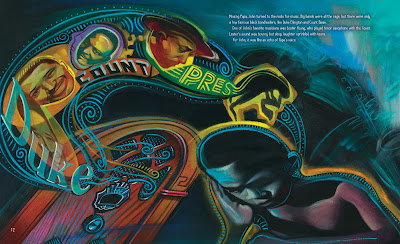National Picture Book Month is the perfect time to highlight this new book by author Gary Golio, who adds John Coltrane to his growing collection of picture book biographies of musical greats. Earlier books, reviewed here on the Fourth Musketeer, profiled Jimi Hendrix and Bob Dylan. While these musicians might not seem like typical fodder for children's picture books, this format, with its striking and inspirational illustrations, is in fact ideal for stimulating young people's interests in these iconic musicians.
The book's title page features the following quote from Coltrane: "My music is the spiritual expression of what I am...I want to speak to their souls." We first meet John Coltrane as a young boy, in North Carolina in 1938, listening to his grandfather preaching on a Sunday morning about the power of the Spirit. John's life was "like a little slice of heaven," with plenty of food, games, and a loving family surrounding him. His father, an amateur musician, filled the house with his singing and tunes from his ukulele and violin.
But at the age of 12, John lost his two grandfathers, his grandmother, and his father in rapid succession. Turning to music for consolation, he was fortunate to receive a used alto sax, which he soon took everywhere, practicing for hours and hours. Moving to Philadelphia, he began playing with big bands and blues groups, and absorbing the music of jazz greats like Charlie "Bird" Parker. Although he was achieving success, life on the road was lonely, and John turned to alcohol and drugs for company, turning away from his spiritual underpinnings. Soon "he had to choose, between the dead end of drugs or a life rich with music." Will he find the strength to get clean and regain his inspiration?
Golio's narrative features Coltrane's spiritual journey front and center, in which he used music in his attempt to "unlock the mysteries of life." Coltrane's spiritual explorations culminated with his masterpiece, A Love Supreme, which Golio poetically describes as the "song of the human heart reaching up to heaven."
In addition to being an accomplished author, Golio is a licensed therapist who specializes in treating addiction problems, which may be part of the reason he feels comfortable interpreting the stories of musicians such as Coltrane and Hendrix for young people. The book's afterword includes a note on musicians and drug use, in which Golio explains that while musicians are no different from other people who use alcohol and drugs to deal with their emotions, they may be even more vulnerable to addiction due to the demands of touring and performing and the belief many artists have that drugs can make a person more "free" or "creative."
 |
| one of the stunning illustrations from Spirit Seeker |
Golio has a gift for expressing music with words, just as Coltrane turned feelings into sounds. But it is impossible to discuss this work without highlighting the outstanding illustration by Rudy Gutierrez, a Pura Belpre Honor-winning artist who has also designed album covers and clearly has an affinity for music. In an artist's note, he explains that he fasted for two weeks and meditated, much as Coltrane did when he composed A Love Supreme, to seek inspiration for illustrating Golio's tribute to Coltrane. The illustrations include acrylic paintings and mixed media pieces done with colored pencils, crayons, and acrylics. The dream-like compositions, dramatic movements and use of contrasting and complementary colors evoke the energy of Coltrane's music. Many of the spreads from the book can be seen on Gutierrez' website.
For more on this book, check out Gary Golio's interview in School Library Journal at this link.





















1 comment:
The illustrations look captivating. I thought the book on Jimi Hendrix was captivating, too.
Thanks for this recommendation.
Tammy
Apples with Many Seeds
Post a Comment